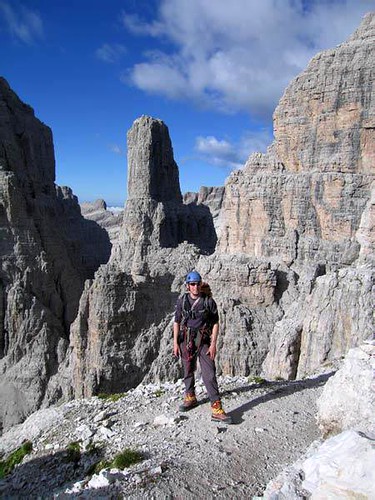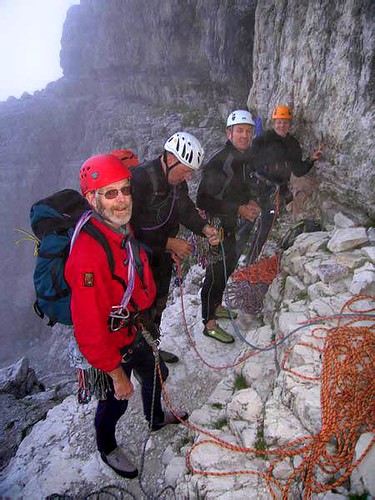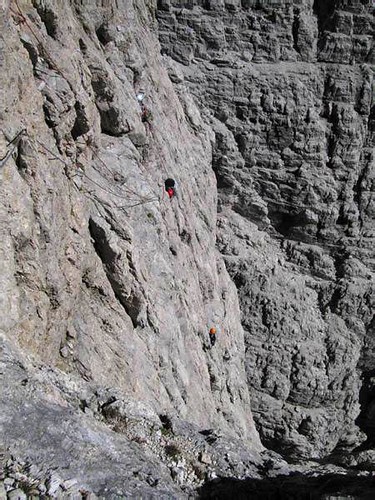The start was from Martin’s house in Ipswich on a grey Thursday afternoon where (under strict orders of no boxes or crates) Steve Gray’s C5 was loaded to the gunwales with all the paraphernalia for a 6pm start. Twenty-four hours later a very tired team pulled into the campsite at Madonna Di Campiglio whacked up the tents and cracked the first beer. In the intervening 1200 miles the main excitement had been the destruction of the nearside wing mirror with an impressively load bang whilst passing the French equivalent of road cones at 70mph – thankfully the car’s owner was driving at the time! Gaffer tape and a vanity mirror got us as far as the Citroen garage at Innsbruck
The following day we decided to start on the Via del Bocchette Alta (or Bugatti alta as Martin insisted on calling it), the classic via ferrata (Iron way) of the Brenta that we planned to do in two days. That afternoon after much faffing and lunch-shopping we headed up the Groste cable car (bliss!) and headed off for a short via ferrata to get us in the swing of things before heading back to the Graffer hut for the evening. A good meal, another beer and a bunkroom to ourselves felt pretty luxurious by alpine standards and we had a relatively relaxed 6am start to look forward to as well. The following day we were out by 6.30 and heading up to the ridge where the Bocchette Alta starts. Initially it’s over ugly ski-developed land but soon we were on an amazing limestone pavement and were being overhauled by a fit Swiss party. At the ridge we started to see cables on the harder sections but the tricky terrain is about Grade 1 or 2 scrambling and you can avoid the cables if you like. Three and a half hours later and we descended rickety ladders to the first col – the not-very-Italian-sounding Bocca Del Tuckett – and eyed up the climb to the day’s high point. We slogged to the top via a series of short ladders with a lunch break halfway and soon we had the plateaux in view where our destination – the Alimonta hut – is sited. So far it had been a lot of walking with a little scrambling and a few ladders, but the next two hours were a series of steep and exposed descents and ascents on ladders in amazing terrain.
 |
| Via Ferrata (click on any image to view in Flickr) |
It was with some relief that we eventually spied the hut around 4pm.
Steve Gray nipped inside with the kitty and soon returned heavily loaded and with a large grin on his face – a ‘birra grande’ turned out to be a full litre – but we weren’t complaining.
 |
| 4 having a beer |
Another fantastic hut with a menu, comfy bunks and copious beer meant the 6am start wasn’t too onerous the next day and we set off back to the col we’d left the previous day and then up a series of ladders. This section was the most spectacular of the trip so far with narrow ledges, rickety wooden walkways, huge drops and views of the big limestone spires and faces, all well-protected with steel cables. 10.00am saw us at the end of the Bochette Alte and all we had to do was get to the Groste cable car back at the start of the route. Thankfully there was an ‘easy’ way back via a lower-level path but still it was a pretty shattered crew who got back to the tents at 6.00 that evening.
The call was for a day off so we headed off for the fleshpots of Trento (surely the underwear capital of the area given the number of such shops) before Martin started talking us into the next objective – the Fehrmann route on a limestone spire called the Campanile Basso.
 |
| Steve C with The Campanile Basso behind |
Martin sagely kept quiet about some of the details of the route, sticking to the line that it was a classic and that he’d done it before without any trouble. It was only after the plan was agreed that it transpired that we had signed up to 13 pitches of up to VS and an abseil descent. The Fehrmann finishes 4/5ths of the way up the Basso and, if you’re quick, you can continue up the ‘easy route’ to the top. We reckoned we’d need to finish the Fehrmann by 1.30 to give us time to get to the top and back down for dinner.
 |
| The start of the Fehrmann at 7am in the mist |
The day didn’t start too well when we followed a knowledgeable-looking Italian team in the fog to completely the wrong place – they were back down before we’d left the ground though and soon we, along with the Italians and a team of four Germans in their 60s, were at the proper start and the Italians disappeared upwards. We got going too, moving as fast as we could and placing what we thought was minimum gear. The Italians and Germans though placed virtually nothing, typically just clipping three pegs on a 40m pitch and soon the Italians were out of sight ahead and all the Germans had overtaken us. 1.30 was now looking optimistic and a small HVS (at least that’s my story) diversion didn’t help. Ultimately we all got to the ledge by 4.30 to see the racing German pensioners descending off the summit above us. Four abseils later we were back on the Bochette Alta, the last half-mile of which constitutes the start of the descent route. A thirty-minute gallop down the moraine and we made the hut five minutes before dinner finished at 8.00 – a memorable day out and at least we beat the Germans back to the hut!
 |
| Steve, Carol & Martin 12 pitches up on the Fehrmann |
Having warmed up in the Dolomites, the decision was made to head to higher things and, after much faffage, we decided on the Ortler Alps just 150k or so North of the Dollies. After seven hours of driving over three passes, some very narrow roads, more hairpin bends than you can shake a stick at and huge numbers of mad motorcyclists and fit pedal-cyclists we ended up at Trafoi just outside the National park area of Sulden – where hotels are permitted (and rich tourists!) but camping clearly constitutes a danger to the National park – Grr.
We headed up the next day to the Dusseldorfer hut which, according to our guidebooks, sat near the foot of a set of glaciers running down from the Hohe Angelus and the Vertainspitze, both around 3500m. Sadly, global warming had done its thing and both glaciers had virtually disappeared to the particular disappointment of those in the team who had bought new crampons and an axe. Still, we were up at 5 the next morning and set off for the Hohe Angelus via the newly exposed rocky ridge and then, on a point of principle, onto the remaining snow and ice to the top. At 9am we were on the top and then it was down onto a huge dry glacier on the far side, clearly melting fast. Dropping the sacks at a col we nipped up the Vertainspitze too before a consultation of the map revealed we had 1000m of descent to make to get back to the chairlift home. With much groaning of knees we slogged downwards over hideous chossy moraine and it was a very relieved team who sat down at the lift station. Here some confusion was caused by the waiter being under the impression that we would like four bears – you’d have thought these dashed foreigners would understand their own language wouldn’t you?
We did a bit of cragging at a very chossy little crag on the Tuesday where we watched a local guide teach belaying techniques that would give Libby Peters a heart attack, and then on the Wednesday went to Bolzano where we took in the Museum where they have ‘Otzi the Iceman’ – well worth a visit.
The plan was then to go back up to a hut and do the big peak in the area, the Ortler, but 2 days of solid rain and a poor forecast decided us on an escape to drier weather cragging in France. Sadly, by the time we got to Dijon it had been raining all day there too and showed no sign of letting up – the restaurant for the evening even had a fire burning in the hearth. The forecast deteriorated further overnight so finally the decision was made to run for home. All in all though a good trip with, for me, the highlights being the fantastic rock and scenery of the Dolomites.
